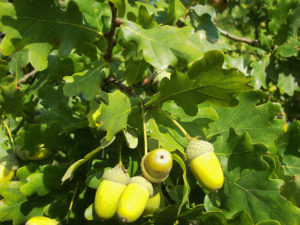- A valuable tree to both insects and wildlife, the quercus robur, or English Oak, provides a home for many different creatures. Q. robur bears the acorns that many animals depend upon for sustenance. Many common human ailments may also be treated with essential oils created from the tree’s bark.
- Latin for “strong, hard timber,” quercus robur is also known as the Pedunculate Oak. The tree is native to Europe and Asia, and has since been planted widely in North America. Large and deciduous, Q. robur can grow up to 82 to 98 feet (25 to 30 meters) tall. English Oaks sport short-stalked, lobed leaves, fissured gray-brown bark, and a stout trunk. Flowering in mid-spring, the tree bears its ripened fruit, acorns, by fall.
Contents
Uses
- Humans use quercus robur for various herbal remedies. The bark is considered a powerful astringent. Diarrhea, laryngitis, burns, cuts, sunburn, kidney problems, and throat problems have all been treated by the home herbal remedy.
Benefits
- The bark has also been used in treating fever, colds, bronchitis, cough, and mild skin inflammation. These treatments are commonly provided as a cold compress, alcohol tincture, tea, or cream.
Cautions
- An average dose of quercus robur is one teaspoon (3 grams). English Oak should not be applied over large areas of the skin. If ingested, it can cause digestive problems. The remedy should also be avoided by people with severe skin inflammation, as it can aggravate the problem.
Interactions
- This is a homeopathic remedy. Please consult your doctor before administering homeopathic remedies and proceed with caution.
Other names
Common oak, pedunculate oak, European oak or English oak
References
Source: Wise Geek, www.wisegeek.com/what-is-quercus-robur.htm

